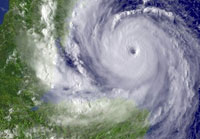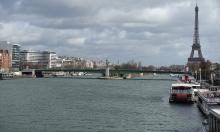Hurricane Dean gains maximum power, threatens Mexican oil industry
Hurricane Dean has strengthened into a Category 5 storm. Dean will most likely cause catastrophic damage as its first rain and winds hit the coasts of Mexico and Belize. Thousands of tourists were forced to end their vacations and leave the beaches of the Mayan Riviera because of the hurricane. Dean may also ravage modern oil installations of the Yucatan Peninsula.

Mexico's state oil company, Petroleos de Mexico, said it evacuated more than 18,000 workers in the southern Gulf of Mexico, which includes the giant Cantarell oil field. Dozens of historically significant Mayan sites also were emptied, and any metal signs or objects that could go airborne in hurricane-force winds were removed.
Dean - which has killed at least 12 people across the Caribbean - quickly picked up strength after brushing Jamaica and the Cayman Islands.
At 0300 GMT (11:00 p.m. EDT), it had sustained winds of 257 kph (160 mph) and was centered about 245 kilometers (150 miles) east of Chetumal, Mexico, the U.S. National Hurricane Center said. The eye was expected to strike near Chetumal early Tuesday morning. Category 5 storms are monstrous, and rare - only three have hit the U.S. since record-keeping began.
Cancun's swank hotels, many of them newly hurricane-proofed, seemed likely to be spared a direct hit. Oil rigs are made of steel, designed to withstand damaging winds. And ancient Mayan sites like the stunning seaside temples at Tulum, about 125 kilometers (75 miles) north of Chetumal, were built from solid limestone.
Dean appeared to be bearing down on the Yucatan's most vulnerable population - the Mayan people - many of whom have seen little of the riches from oil or tourism, and still live in traditional wooden slat huts in small settlements all over this low-lying area.
Meteorologists said a storm surge of four to six meters (12 to 18 feet) was possible at the storm's center, which could push sea water deep inland. Heavy rains threatened to inundate the swampy region.
Civil Defense trucks roamed the darkened streets of Tulum Monday night urging people to remain indoors, as heavy rain from the storm's outer bands began lashing the coast. Locals and tourists alike stood expectantly on balconies and porches as violent thunderclaps boomed and ominous of clouds rolled in over the reddish twilight.
"We have food, and our house is right there, but it's kind of low so we came here to make sure we were higher," said 29-year-old Nicholas Flaherty of Asheville, North Carolina. He spoke from the raised verandah of a bunkhouse where he and other workers for the volunteer network Global Vision International gathered for safety.
Earlier Monday, as he nailed up boards across his store's windows, Israel Martinez expressed the kind of cold logic that rules a coast marked by contrasts of poverty and wealth, Indian and outsider.
"The less the tourist centers are affected, the faster the recovery will be," said Martinez, 28, a non-Indian who has lived in Tulumfor 15 years. "Nobody wishes ill upon their neighbors, but if some of these smaller towns are hit, they can be repaired faster," without affecting the area's lifeblood, tourism.
President Felipe Calderon said he would cut short a trip to Canada where he is meeting with U.S. President George Bush and Canadian Prime Minister Stephen Harper, and travel Tuesday to the areas where the hurricane is expected to hit.
A hurricane warning was in effect from Cancun all the way south through Belize, as well as parts of the Yucatan's western coast.
In Belize, the government evacuated Caye Caulker and Ambergris Caye - both popular with U.S. tourists - urged people to leave low-lying areas and ordered a dusk-to-dawn curfew from Belize City to the Mexican border.
Authorities evacuated Belize City's three hospitals and were moving high-risk patients to the inland capital, Belmopan, which was founded after 1961's Hurricane Hattie devastated Belize City. Mayor Zenaida Moya urged residents to leave, saying Belize City does not have shelters strong enough to withstand a storm of Dean's size.
Small aircraft company Tropic Air, one of the country's two airlines, said it was moving its fleet to Guatemala.
The storm was expected to slash across the Yucatan and emerge in the Gulf of Campeche, where Petroleos de Mexico decided Monday to shut down production on the offshore rigs that extract most of the nation's oil - resulting in a production loss of 2.7 million barrels of oil and 2.6 billion cubic feet of natural gas a day.
Central Mexico was next on the storm's path, though the outer bands were likely to bring rain, flooding and gusty winds to south Texas, already saturated after an unusually rainy summer.
At the southern tip of Texas, sandbags were distributed in the resort town of South Padre Island, and residents were urged to evacuate. "Our mission is very simple. It's to get people out of the kill zone, to get people out of the danger area, which is the coastline of Texas," said Johnny Cavazos, Cameron County's chief emergency director.
In Mexico during the past three days, officials put more than 50,000 people on flights leaving various parts of the Yucatan peninsula, the federal Communications and Transportation Department said in a statement.
Though expected to escape a direct hit, Cancun still could face destructive winds, since the storm swirled over 195,000 square kilometers (75,000 square miles), twice the size of South Korea (about the size of South Dakota).
Cancun's tourist strip is still marked with cranes used to repair the damage from 2005's Hurricane Wilma, which caused US$3 billion (EUR 2.2 billion) in losses. Dean is expected to be even stronger than Wilma, which stalled over Cancun and pummeled it for a day.
The worst storm to hit Latin America in modern times was 1998's Hurricane Mitch, which killed nearly 11,000 people and left more than 8,000 missing, most in Honduras and Nicaragua.
Subscribe to Pravda.Ru Telegram channel, Facebook, RSS!




